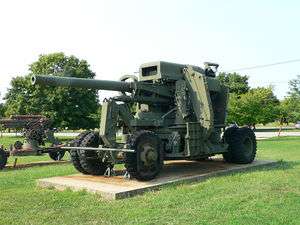120 mm M1 gun
| 120 mm M1 gun | |
|---|---|
|
A 120 mm M1 anti-aircraft gun at US Army Ordnance Museum. | |
| Type | Anti-aircraft gun |
| Place of origin | United States |
| Service history | |
| Used by | U.S. Army |
| Wars | World War II and Korean War |
| Specifications | |
| Weight | 64,000 lb (29,000 kg) |
| Length | 24½ feet (7.39 m) |
| Barrel length | 23½ feet (7.16 m) |
| Crew | A gun commander, a gunner with an eight man squad, and an ammunition chief supervising two ammunition handlers - a total of thirteen men. |
|
| |
| Shell | 120×775 mm. R |
| Caliber | 120 mm L/60 |
| Barrels | 1 |
| Breech | vertical sliding wedge |
| Recoil | hydropneumatic |
| Carriage | towed |
| Elevation | 80 Deg. |
| Traverse | 360 Deg. |
| Rate of fire | 12 rounds per Min. |
| Muzzle velocity | 3,100 ft/s (945 m/s) |
| Maximum firing range | 81,000 ft (24,700 m), 57,500 ft (17,500 m) maximum altitude |
The 120 mm Gun M1 was the United States Army's standard super-heavy anti-aircraft gun, complementing the smaller and more mobile M2 90 mm gun in service. Its maximum altitude was about 60,000 ft (18,000 m), which earned it the nickname stratosphere gun.
The M1 gun was used by the Army for air defense from 1944 to 1960. The 120 served primarily in static defensive roles, although it had been designed to be mobile. It became obsolete with the development of anti-aircraft missiles and was phased out after 1954.
History
The Army first worked on a 120 mm gun after the end of World War I, with a prototype being presented in 1924. The system was considered far too heavy and expensive to be useful, and the project slowed down, although it was never canceled outright.
In 1938, the Army reviewed its needs for newer AAA systems and decided to order new systems for both the heavy and super-heavy role. The former was filled by the new M1 90 mm gun, which replaced the earlier M3 3-inch gun then in use. For the super-heavy role, the 120 mm gun design was dusted off and mated to a new eight-wheel carriage, designated 4.7-inch M1 when it was accepted in 1940.
Like the 90 mm, the M1 gun was typically operated in a battery of four guns, initially with an associated searchlight, SCR-268 radar (replaced later by the much-improved SCR-584), M10 gun director, and M4 Gun Data Computer that automatically laid the guns. The M6 Tractor was used as the prime mover.
The M1 gun entered service late in World War II. One battalion of M1 guns, the 513th AAA Gun Battalion, was deployed in the Philippines in February 1945, but never fired on any hostile aircraft.
After World War II ended and the Cold War with the Soviet Union began, M1 guns were deployed in many locations in the U.S. and Canada. To defend against long range Soviet Tu-4 bomber attack, the Army Anti-Aircraft Command (ARAACOM) formed 44 active duty and 22 National Guard battalions equipped with M1 guns, divided into seven brigades and 20 anti-aircraft artillery groups. Two Canadian anti-aircraft battalions were also equipped with M1 guns for the joint defense of the Soo Locks. These guns were guided by the long range Lashup Radar Network equipped with AN/CPS-5. M1 guns were deployed for the protection of nuclear production facilities, major industrial centers, strategic air force bases, and select major population centers.
In 1954, the MIM-3 Nike Ajax surface-to-air missile became operational with ARAACOM. It substantially outranged the M1 gun, rendering it obsolete. ARAACOM began retiring the M1 gun from active-duty units and then from National Guard units. Then in 1957, the Soviet Union introduced the R7, its first ICBM, and the M1 gun became practically useless. By January 1960, all remaining National Guard units with M1 guns were converted to Nike missiles or deactivated.
Comparable weapons
- 12.8 cm FlaK 40 - Nazi Germany
- 130 mm air defense gun KS-30 - Soviet Union 1950
- QF 4.5-inch Mk I – V naval gun - Britain 1938, see land use
See also
- List of U.S. Army weapons by supply catalog designation (SNL D-32)
- Director (military)
- Rangekeeper
- Gun Data Computer
- Fire-control system
- Kerrison Predictor
References
- TM 9-2300 Standard Artillery and Fire Control Materiel dated 1944
- TM 9-380
- SNL D-32
External links
| Wikimedia Commons has media related to 120mm gun M1. |
